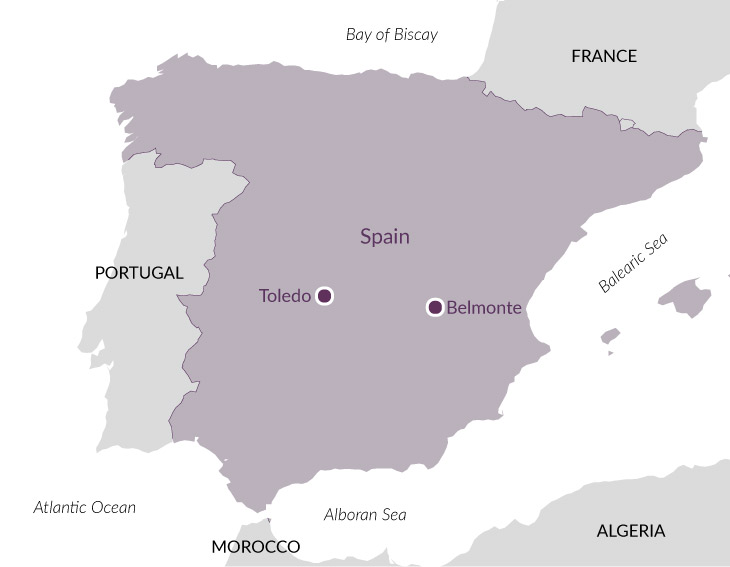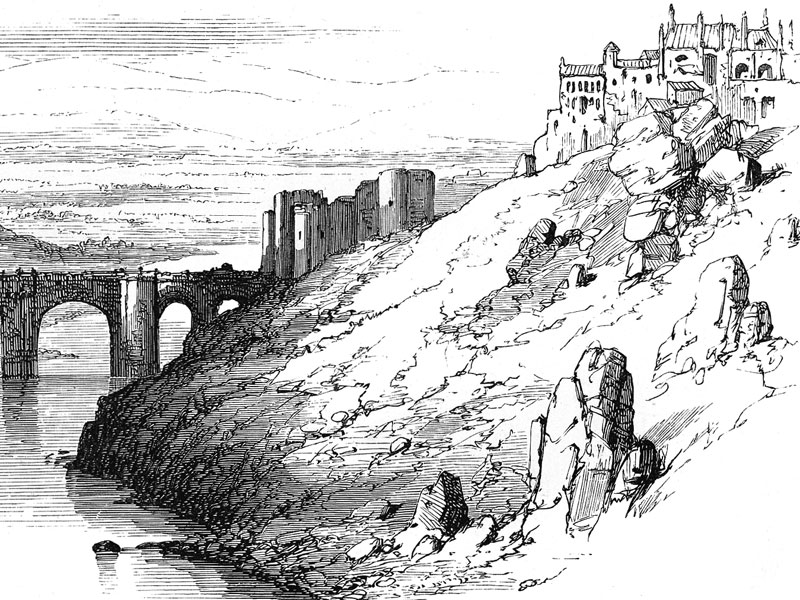Overview
‘Somewhere in La Mancha, in a place whose name I do not care to remember, a gentleman lived not long ago, one of those who has a lance and ancient shield on a shelf and keeps a skinny nag and a greyhound for racing.’ Don Quixote, Miguel de Cervantes.
Vast plains, flocks of dun-coloured sheep lifting clouds of dust, hundred-year-old gnarled vines in serried rows to the distant horizon, windmills, and cirrus clouds high overhead…this is La Mancha; a secret and arcane world, still astonishingly authentic and wonderfully unspoilt.
We begin in the sleepy town of Belmonte, a case study in the history of Spain. Beneath the castle walls, the Jewish and Arab quarters remain intact. Once home to craftsmen who created some of the country’s finest and most intricate artesonado ceilings, this historic core was transformed later by Empress Eugenie of France into a nineteenth-century romantic hideaway before the great Alba dynasty took control. No wonder it formed the set of the epic El Cid – with Charlton Heston and Sophia Loren gracing the landscape.
Pastrana possesses a rare and remarkable set of fifteenth-century tapestries, created in response to historical events, while Villaescusa de Haro houses a completely unknown yet spectacular high altar and sacristy – a pocket-sized Pantheon – one of the great unsung masterpieces of the Renaissance genius Andrés de Vandelvira.
From Belmonte we search out the archaeological site of Roman Segobriga, built on the wealth of the lapis specularis mines, and Cuenca with its precipitous hanging houses and Gothic cathedral built over the recently rediscovered Arab palace. Here, too, is the pioneering Museum of Abstract Art. Travelling west to Toledo we stop at the Bourbon palace of Aranjuez, with romantic gardens and formal parterres, stretching out along the banks of the Tagus; a favourite late-spring escape from hell-hot Madrid.
Toledo is closely associated with El Greco, and a private viewing of the breathtaking Burial of the Conde Orgaz offers a valuable insight into why the Cretan artist dared to imagine this masterpiece; a triumphant response to Michelangelo’s Sistine Chapel.
But this Imperial City of the three faiths is much more than El Greco: the Visigothic museum is an eclectic marriage of Arab, Gothic, Renaissance and Romanesque and a perfect example of Toledo’s Janus-headed capacity to play off the Inquisition versus stylistic tolerance; the Renaissance Hospital de Tavera is the ideal counterpoint to the great fourteenth-century Synagogue of El Transito and the exquisite tenth-century mosque of Bab al-Mardum; and then to surrealists Luis Buñuel and Salvador Dalí, who adored getting lost in the meandering Arab street plan, enjoying alcohol fuelled ‘Toledan Nights’ as they feasted on pickled partridge and convent marzipan.
Day 1
London to La Mancha. Fly at c. 9.15am (Iberia Airlines) from London Heathrow to Madrid. Drive east into La Mancha to the mediaeval town of Pastrana. See some of the finest surviving Gothic tapestries, depicting the conquests in Morocco by Alfonso V, King of Portugal (1432–1481). Continue to the walled town of Belmonte for the first of three nights.
Day 2
Belmonte, Segobriga, Villaescusa de Haro. In Belmonte visit the Gothic church of San Bartolomé and the superbly sited 15th-century castle. The Roman city of Segobriga reached its peak in the 1st century ad and was abandoned during the Islamic conquest of Spain. Ruins of the theatre, forum and baths remain in a pleasingly remote setting. Return via the remarkable parish church of Villaescusa de Haro. Dinner in nearby Las Pedroñeras.
Day 3
Cuenca. The old town sits high on a narrow ridge bound by rivers, the castle ramparts at the top affording spectacular views. The predominantly Gothic cathedral has Plateresque portals and carved wooden ceilings. One museum has two works by El Greco, another has Roman remains. The Museum of Abstract Art has an important collection of Saura, Tàpies, Chillida and others.
Day 4
Aranjuez, Toledo. To Aranjuez, with its 18th-century royal landscaped park and elaborately decorated palaces. Visit the best of Toledo’s Mozarabic churches, San Román now the Visigothic museum. First of four nights in Toledo.
Day 5
Toledo. The Gothic cathedral is Spain’s largest and the most richly endowed with paintings (El Greco, Velázquez, Titian) and also has furnishings and sculpture of the highest quality. The Museo de Santa Cruz is housed in a remarkable early 16th-century hospital built to the designs of Antón and Enrique Egas, and is best known for its late mediaeval and later paintings, including works by El Greco.
Day 6
Toledo. Visit the church of Santo Tomé with El Greco’s Burial of Count Orgaz, his greatest work (private view). See more of his work and his burial place at the convent of Sto Domingo. Beyond the city gates is the 16th-century Hospital de Tavera, now a museum containing El Greco’s final work, Baptism of Christ.
Day 7
Toledo. Morning spent in the old Jewish quarter, starting with a pair of former synagogues. Ibn Shoshan (Santa María la Blanca) from the 13th century retains its original stuccowork and wooden ceiling, while El Tránsito is a more lavish galleried synagogue financed by Samuel Levi in the 1360s. San Juan de los Reyes is the breathtakingly ambitious Franciscan monastery constructed under Ferdinand and Isabella. El Greco’s house and museum contains his finest series of apostles and View of Toledo.
Day 8
Illescas. El Greco spent two years in the undistinguished town of Illescas and the Hospital de la Caridad contains five of his works. Fly to Heathrow (British Airways) arriving at c. 7.40 pm.
Price, per person
Two sharing: £2,420 or £2,280 without flights. Single occupancy: £2,860 or £2,720 without flights.
Included
Air travel (economy class) on scheduled Iberia Airlines & British Airways flights (aircraft: Airbus 320), travel by private coach for transfers, accommodation as described below, breakfasts, 1 lunch and 4 dinners with wine, water and coffee, all admission to museums, etc., all tips for restaurant staff and drivers, all taxes, the services of the lecturer and tour manager.
Accommodation
Hotel Infante Don Juan Manuel, Belmonte: 4-star hotel built on the ancient fortress of Belmonte. Hotel Fontecruz, Toledo: 4-star hotel in a converted palace in the Jewish Quarter with smart rooms. Single rooms are doubles for sole use throughout.
How strenuous?
The tour involves a lot of walking in town centres where coach access is restricted. Many streets are narrow, steep and unevenly paved. There is a lot of standing in museums and churches. Average distance by coach per day: 63 miles.
Group size
Between 10 and 22 participants.
Are you fit enough to join the tour?
Travel advice
Before booking, please refer to the FCDO website to ensure you are happy with the travel advice for the destination(s) you are visiting.

